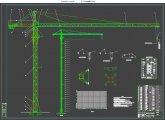不同温度水冷壁管组织劣化速率研究(含CAD图)

不同温度水冷壁管组织劣化速率研究(含CAD图)(任务书,开题报告,外文翻译,实习报告,论文说明书10000字,CAD图3张)
摘要
水冷壁是锅炉的蒸发受热面,吸收炉膛高温火焰的辐射热,把水加热并逐步变成饱和蒸汽和水的混合物。其工作条件相当差,由于热辐射、低负荷、结渣、结垢等原因会使水冷壁的传热能力降低。
本课题先对锅炉和水冷壁管做简单的介绍,然后分析水冷壁管常见的失效形式及原因(以超温爆管失效为主),研究20G钢不同劣化程度对机械性能的影响。本课题从锅炉水冷壁管超温后的组织及蠕变行为入手,对超温条件下水冷壁管的组织以及蠕变行为进行研究,为准确预测炉管寿命提供一定是参考。通过实验设计和加工试样高温拉伸试样以及高温蠕变持久试样,完成450-700℃下的高温拉伸试验及蠕变持久试验,对高温拉伸以及高温蠕变持久试验结果进行分析总结。
关键词:水冷壁 超温 蠕变实验
Research on unequal temperature water wall tube organization degradation rate speed
Abstract
Water wall tube is the boiler’s evaporating heating surface. Absorb radiant heat furnace of high temperature flame, heating water and gradually become saturated steam and water mixture. Its working condition is very poor, due to the heat radiation, low load, slagging, fouling and other reasons will reduce the heat capacity of water wall tube. [资料来源:http://www.doc163.com]
This topic first make a simple introduction about the boiler and the water wall tube , then analyzes the failure forms and reasons of common water wall tube (with overtemperature tube burst failure mainly), the effects of 20G steel in different degradation degree on mechanical properties. This topic make a research on the water wall tube ’s creep behavior and organization after ultra high temperature, offer reference for accurate prediction life of water wall tube. Through the experimental design and processing of high temperature tensile specimen and high-temperature creep rupture specimens, the high temperature tensile test and creep of 450-700 ℃ endurance test. the high temperature tensile and creep rupture test results were analyzed and summarized.Last we need make analysis and summary of the high temperature tensile and creep rupture test results .
Key Words: Water wall tube High temperature Creep experiment




目录
摘要.................................................................................................................................I [资料来源:http://doc163.com]
ABSTRACT..................................................................................................................II
第一章 绪论...................................................................................................................1
1.1锅炉简介............................................................................................................1
1.2水冷壁管简介....................................................................................................2
1.3水冷壁管常见失效形式....................................................................................3
1.4 蠕变持久实验研究...........................................................................................5
1.5 本课题研究内容...............................................................................................9
第二章 高温机械性能试验.......................................................................................10
[资料来源:http://doc163.com]
2.1 实验材料............................................................................................................10
2.2 试验设备...........................................................................................................10
2.3 试验用试样........................................................................................................11
2.4 实验数据记录分析............................................................................................11
第三章 蠕变持久性能试验........................................................................................14
3.1引言......................................................................................................................14
3.2 试验研究.............................................................................................................14
3.3 试验结果及分析.................................................................................................16 [版权所有:http://DOC163.com]
3.4 本章小结.............................................................................................................18
第四章 总结与展望......................................................................................................19
4.1 总结.......................................................................................................................19
4.2 展望......................................................................................................................19
参考文献............................................................................................................................20
致谢.....................................................................................................................................23
[资料来源:http://Doc163.com]
